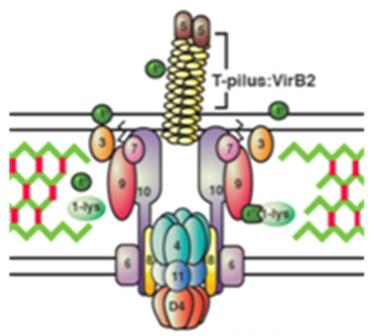Research regarding cell growth, division in Agrobacterium
Plant & Microbial Biology Professor Patricia Zambryski has been awarded $1,650,766 from the National Science Foundation to study Assembly of the Agrobacterium Virulence Specific Type IV Secretion System in the Context of Bacterial Cell Growth and Peptidoglycan Synthesis.
The funds will allow the Zambryski lab to continue to study the remarkable soil bacterium Agrobacterium tumefaciens. Fundamental insights applicable to numerous areas of bacterial and plant biology have been uncovered by investigations into Agrobacterium. The funds are especially critical to support Dr. John Zupan, a research specialist in the Zambryski Lab, who has contributed substantially to this effort for over 20 years.
In nature, Agrobacterium causes crown gall disease (tumors) in plants, which it accomplishes by transferring a particular segment of DNA from itself into plant cells. The ability to transfer bacterial DNA into plant cells has led to the use of Agrobacterium as the quintessential vector for transforming plants with DNA of interest. The bacterial DNA (along with accessory proteins) is transported into plant cells by the Type 4 Secretion System (T4SS) of the bacterium.

However, exactly how DNA and proteins are transported out of the bacterial cell and into the plant cell by the T4SS remains unknown. The Zambryski lab showed that multiple T4SS form around the entire circumference of the bacterial cell; see image with optical sections through a bacterial cell where each T4SS is green.
 Each T4SS spans from the inner membrane to the outer membrane and must therefore insert itself repeatedly through the bacterial cell wall, called the peptidoglycan (PG) layer; in the cartoon 11 proteins of the T4SS span from the inner to outer membranes (double horizontal lines) through the green and red PG layer.
Each T4SS spans from the inner membrane to the outer membrane and must therefore insert itself repeatedly through the bacterial cell wall, called the peptidoglycan (PG) layer; in the cartoon 11 proteins of the T4SS span from the inner to outer membranes (double horizontal lines) through the green and red PG layer.
The above results provoke the overall question that will be addressed in the NSF supported studies. How do T4SS channels insert through the bacterial membranes and PG cell wall at numerous locations around the cell? To answer this question requires delving into how Agrobacterium grows and divides. While bacterial growth, cell division, and PG synthesis are well studied and understood in model systems like E. coli, Agrobacterium grows in a different manner where cells elongate from only one end of the bacterial cell. This project will use fluorescence microscopy, genetics, bioinformatics and biochemistry to investigate how Agrobacterium T4SS inserts into the PG layer.
Microbial and Plant Biologist
Dr. Zambryski is a plant and microbial biologist and also serves as the department's Graduate Student Advisor. Her lab researches Agrobacterium and Plasmodesmata.
The lab performs research in two distinct areas. In microbial biology they study the molecular mechanisms utilized by Agrobacterium that leads to the genetic transformation of plant cells. In plant biology they study how plant cells communicate with each other via unique plant specific intercellular structures called plasmodesmata.
Link to Prof. Zambryski's page on the PMB web site: pmb.berkeley.edu/profile/zambryski
